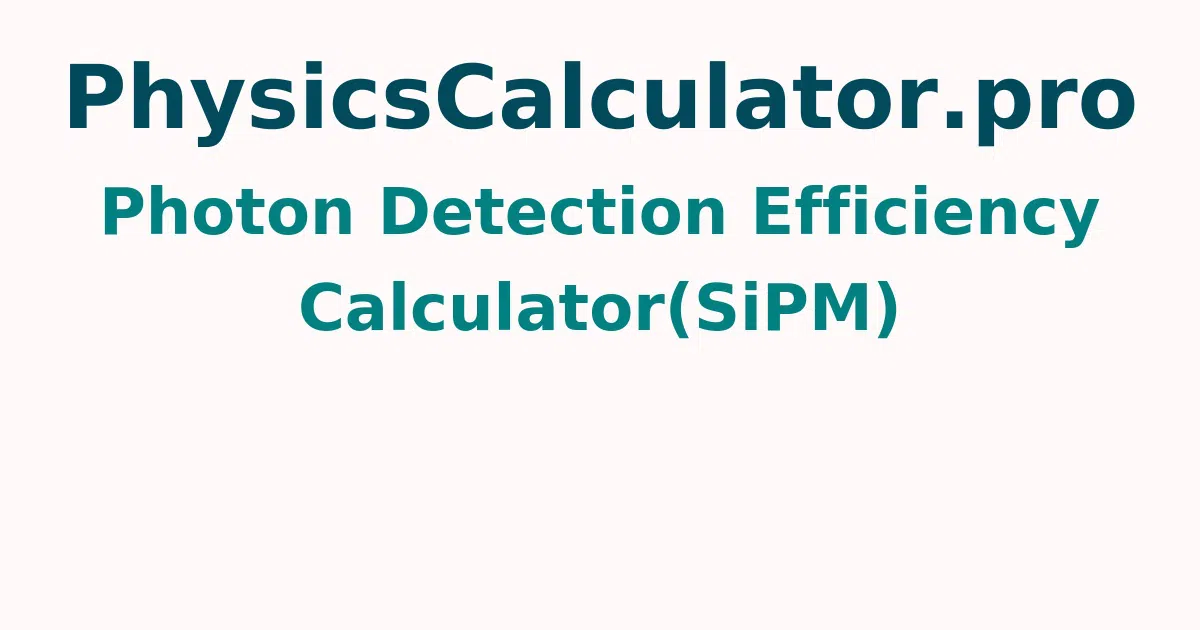Photon Detection Efficiency Calculator(SiPM)
The Photon Detection Efficiency Calculator (SiPM) is a useful tool for calculating photon detection efficiency (PDE). This simple calculator accepts gain, afterpulsing probability, crosstalk probability, wavelength, and resilience as inputs and produces PDE in a matter of seconds.
What is Photon Detection Efficiency (PDE) and How to Calculate it?
In the sections below, you'll find a detailed step-by-step process for calculating SiPM's photon detection efficiency. To achieve the desired effect, obtain the steps and carefully follow them.
- Step 1: Note the SiPM gain, crosstalk probability, afterpulsing probability, wavelength, and responsiveness.
- Step 2: Get the PDE formula and fill in the blanks with the given values.
- Step 3: Check the output by doing the relevant math procedures.
Photon Detection Efficiency Formula
The photon detection efficiency of SiPMs is measured and evaluates their sensitivity. The following is the PDE formula
PDE = (R x h x c)/[e x λ x G(1 + P_XT) (1 + P_AP)]
- Where,
- PDE = photon detection efficiency
- h = planck's constant (6.626 x 10-34 m²kg/s)
- c = speed of light (2.998 x 108 m/s)
- e = elementary charge (1.602 x 10-19 C)
- R = responsivity
- λ = wavelength of the incident light
- The gain, or amount of charge created for each detected photon, is called G.
- P_XT = crosstalk probability
- P_AP = afterpulsing probability.
The sensor's responsiveness can also be calculated using this PDE calculation.
How to Use the Photon Detection Efficiency Calculator?
The following is the procedure how to use the Photon Detection Efficiency calculator
- Step 1: Input the unknown values like gain, afterpulsing probability, crosstalk probability, wavelength, and responsivity and x in the appropriate input fields.
- Step 2: To acquire the result, click the "Calculate the Unknown" button.
- Step 3: Finally, the output field will show the Photon Detection Efficiency value.
For more concepts check out physicscalculatorpro.com to get quick answers by using this free tool.
FAQs on Photon Detection Efficiency
1. What is the definition of photon detection efficiency?
The ratio of the number of photons released by microcells to the number of incident photons is called the photon detection efficiency.
2. What does SIPM stand for?
Silicon Photomultiplier (SIPM) is an acronym for Silicon Photomultiplier. It's a solid-state photodetector that generates a current pulse of 10^5 to 10^6 electrons in response to photon absorption.
3. What is the process of converting a photon to an electron?
The "photovoltaic" effect transforms photons into electrons in photovoltaics (photo meaning light, and voltaic meaning electricity). The photovoltaic effect occurs when photons from the sun strike the surface of a silicon semiconductor material, causing free electrons to be liberated from the atoms.
4. How can photons dislodge electrons?
When a photon collides with an electron, some of its energy is used to remove the electron. The photon's remaining energy is transferred to a free negative charge known as a photoelectron.
5. When a photon collides with a solar cell, what happens?
When photons of light strike our solar cell, their energy separates electron-hole pairs. Each photon with sufficient energy will generally liberate exactly one electron, as well as a free hole.
